- Second Opinion
A Child's First Dental Visit Fact Sheet
When should your child first see a dentist? You can take your child at a younger age, but experts recommend taking him or her within 6 months of the first tooth coming in (erupting), or by about 12 months at the latest.
At this time, the dentist can give you information on:
Baby bottle tooth decay
Infant feeding practices
Mouth cleaning
Pacifier habits
Finger-sucking habits

Prepare your child
If possible, schedule morning appointments so young children are alert and fresh.
Prepare a preschooler or older child for the visit by giving him or her a general idea of what to expect. Explain why it is important to go to the dentist. Build excitement and understanding.
Prepare yourself
Discuss your questions and concerns with the dentist. Remember that your feeling toward dental visits can be quite different from your child's. Be honest with your view of the dentist. If you have dental anxieties, be careful not to relate those fears or dislikes to your child. Parents need to give moral support by staying calm while in the dental exam room. Children can pick up parents' anxieties and become anxious themselves.
Prepare the dentist
At the first visit, give the dentist your child's complete health history. For a restoration visit, such as getting a cavity filled, tell the dentist if your child tends to be stubborn, defiant, anxious, or fearful in other situations.
Watch how your child reacts. Many parents are able to guess how their child will respond and should tell the dentist. Certain behaviors may be linked to your child's age:
10 to 24 months. Some securely attached children may get upset when taken from their parents for an exam.
2 to 3 years. A securely attached child may be able to cope with a brief separation from parents. In a 2-year-old, "no" may be a common response.
3 years. Three-year-olds may not be OK being apart from a parent when having a dental procedure such as getting a cavity filled. This is because most 3-year-olds are not socially mature enough to separate from parents.
4 years. Most children should be able to sit in another room from parents for exams and treatment procedures.
The first visit
Your child's first dental visit is to help your child feel comfortable with the dentist. The first dental visit is recommended by 12 months of age, or within 6 months of the first tooth coming in. The first visit often lasts 30 to 45 minutes. Depending on your child's age, the visit may include a full exam of the teeth, jaws, bite, gums, and oral tissues to check growth and development. If needed, your child may also have a gentle cleaning. This includes polishing teeth and removing any plaque, tartar, and stains. The dentist may show you and your child proper home cleaning such as flossing, and advise you on the need for fluoride. Baby teeth fall out, so X-rays aren’t often done. But your child's dentist may recommend X-rays to diagnose decay, depending on your child's age. X-rays are also used to see if the root of a jammed baby tooth may be affecting an adult tooth. In general, it is best that young children not have dental X-rays unless absolutely needed.
The second visit
Just like adults, children should see the dentist every 6 months. Some dentists may schedule visits more often, such as every 3 months. This can build comfort and confidence in the child. More frequent visits can also help keep an eye on a development problem.
Protect your children's teeth at home
Here are some tips to protect your children's teeth:
Before teeth come in, clean gums with a clean, damp cloth.
Start brushing with a small, soft-bristled toothbrush and a very small amount of toothpaste (the size of a grain of rice) when your child's first tooth appears. Use a pea-sized dab of fluoridated toothpaste after 3 years of age. This is when the child is old enough to spit out the toothpaste after brushing.
Prevent baby bottle tooth decay. Don't give children a bottle of milk, juice, or sweetened liquid at bedtime or when put down to nap.
Limit the time your child has a bottle. Your child should empty a bottle in 5 to 6 minutes or less.
Help your child brush his or her own teeth until age 7 or 8. Have the child watch you brush, and follow the same brushing pattern to reduce missed spots.
Limit foods and treats that increase tooth decay. This includes hard or sticky candies, fruit leather, and sweetened drinks and juice. Offer fruit rather than juice. The fiber in fruit tends to scrape the teeth clean. Juice just exposes the teeth to sugar.
- Pediatric Cardiology
- Our Services
- Chiari Malformation Center at Stanford Medicine Children's Health
Related Topics
Dental Care for Infants and Children
Adolescent Problems of the Teeth and Mouth
Connect with us:
Download our App:
- Leadership Team
- Vision, Mission & Values
- The Stanford Advantage
- Government and Community Relations
- Get Involved
- Volunteer Services
- Auxiliaries & Affiliates
© 123 Stanford Medicine Children’s Health
When Should Baby Visit the Dentist for the First Time?
Medical review policy, latest update:, when to schedule baby's first dental visit, how to choose a dentist for your child, read this next, what happens at baby's first dentist visit, tips to make your child’s dentist visit easier, how often to visit the dentist.
Based on how your toddler’s teeth look, your dentist will let you know when to make the next visit. Most experts recommend that toddlers see the dentist about every six months — as long as there are no major problems. So don’t forget to schedule your child’s second appointment on your way out the door!
What to Expect the First Year , 3rd Edition, Heidi Murkoff. What to Expect the Second Year , Heidi Murkoff. WhatToExpect.com, Toddler Dental Care , March 2019. WhatToExpect.com, Is Your Toddler Teething? , April 2020. WhatToExpect.com, Preventing Cavities and Keeping Baby's Teeth Healthy , April 2020. WhatToExpect.com, Brushing Baby's Teeth , July 2020. American Academy of Pediatrics, Baby's First Tooth: 7 Facts Parents Should Know , November 2020. American Academy of Pediatrics, Good Oral Health Starts Early , November 2020 American Academy of Pediatric Dentistry, Frequently Asked Questions , 2021. American Dental Association, Taking Care of Your Child’s Smile , May 2014.
Go to Your Baby's Age
Trending on what to expect, the covid-19 vaccine for infants, toddlers and young children, how to create a night shift system when you have a newborn, ⚠️ you can't see this cool content because you have ad block enabled., when do babies start laughing, baby-led weaning, what happens in the ‘4th trimester’ (and is it a real thing).
- Trying to Conceive
- Signs & Symptoms
- Pregnancy Tests
- Fertility Testing
- Fertility Treatment
- Weeks & Trimesters
- Staying Healthy
- Preparing for Baby
- Complications & Concerns
- Pregnancy Loss
- Breastfeeding
- School-Aged Kids
- Raising Kids
- Personal Stories
- Everyday Wellness
- Safety & First Aid
- Immunizations
- Food & Nutrition
- Active Play
- Pregnancy Products
- Nursery & Sleep Products
- Nursing & Feeding Products
- Clothing & Accessories
- Toys & Gifts
- Ovulation Calculator
- Pregnancy Due Date Calculator
- How to Talk About Postpartum Depression
- Editorial Process
- Meet Our Review Board
How to Prepare Your Child for Their First Dental Visit
Verywell / Madelyn Goodnight
What to Expect
Choosing a dentist.
- Getting Ready For The Visit
Preparing as a Parent
One of the most frequently asked questions I get as a Pediatric Dentist is, “When should I bring my baby in for their first dental visit?”
The Academy of Pediatric Dentistry recommends that a child should visit the dentist when the first tooth appears or no later than their first birthday. While it may sound early, starting at that age will start your baby on a path for great oral health and prevent a number of dental problems that can occur during childhood.
The first visit gives parents a chance to become educated on how to properly care for their child's teeth and gives children a chance to become comfortable with the dental environment at an early age.
At the first visit, the dentist will examine your baby's mouth to make sure everything is growing and developing properly and will check for dental caries, tongue ties, and any signs of injuries.
The dentist will typically tell you everything you need to know to keep your child's teeth healthy including:
- What kind of toothpaste and toothbrush to use
- Brushing and flossing techniques
- How to relieve teething discomfort
- Which foods and drinks cause cavities
- Answers to questions about pacifier use and thumb-sucking.
The examination and cleaning itself can take just a few minutes, but most of the time is spent on making the child feel comfortable and educating the parents. You should not expect the overall visit to take a long time.
The first step is finding a Pediatric Dentist for your child. Pediatric Dentists have two to three additional years of training after dental school during which they extensively study child development, behavior management of patients from infancy to adolescence, and how best to work with special needs children.
Most Pediatric Dentists will aim to provide a fun environment with toys, stickers, TVs, games, yummy flavored toothpaste, and staff that enjoy working with children. When children are having fun, they gain trust in the dentist and staff, and will often enjoy their visits and look forward to their next appointment.
Where to Find a Dentist
To find a Pediatric Dentist in your area, you can Google nearby pediatric dentists, talk to other parents you know for recommendations, and ask your child's pediatrician or your own dentist. If you have dental insurance, you can search for a Pediatric Dentist through your list of participating providers.
Getting Ready For Your Child's Visit
When you have decided on an office, call them to schedule a visit. Young children tend to do their best in the morning when they are fresh and full of energy. Avoid scheduling appointments late in the day or close to nap times when children can be groggy or cranky.
You can inquire if it is possible for you and your child to come to the office for a tour and to meet the doctor before the actual day of the checkup. If your child has any special needs, discuss it with the staff member that schedules your appointment. The dentist will often want a little extra time scheduled for this.
If there is something in particular that keeps your child calm and happy (a song they like to hear, a video they like to watch or simply a color they like), let the dentist know so they can try to incorporate that into the visit.
Mental Preparation
Once you have an appointment scheduled, start preparing your child for the visit. Children learn best when they are having fun. You can practice giving their stuffed animal a checkup with a toy mirror.
Your child can bring that same stuffed animal to the dental visit to get a check-up by the dentist. Read books to them. I recommend:
- Show Me Your Smile! A Visit to the Dentist (Dora the Explorer)
- Dentist Trip (Peppa Pig)
- Elmo Visits the Dentist by P.J. Shaw
You can also watch one of the many YouTube videos about going to the dentist, such as Daniel Tiger's .
Put Them At Ease
When talking to your child about their upcoming trip to the dentist, you can assure them that there are no shots at this visit and that the dentist will simply examine and brush their teeth and talk to them about how to keep their teeth healthy.
Let them know that the dentist will show them all of the tools and explain all of the procedures before starting. You can also plan a treat (not candy or junk food) such as a trip to the park or toy store should they need a little extra motivation.
Anticipating Follow Up Visits
Once you've completed your first visit, it's time to start preparing your child for their second visit! Discuss the visit with your child and remind them of the positive things that happened such as:
- There were no shots
- Nothing hurt
- The toothpaste tasted great
- The toothbrush tickled
- The dentist counted all of your teeth and now we know how many teeth you have
- You got prizes and a new toothbrush at the end
- Next time we go there, we'll get these fun prizes all over again!
To prepare yourself, come on time, if possible a few minutes earlier to fill out any registration and consent forms that may be needed. Many offices have their registration forms on their website so you can fill them out in advance.
Give your dentist a complete health history of your child. If your child is taking any medications, have a list of the medications and dosages. Have your child's pediatrician's contact information available.
If you have any particular questions that you want the dentist to address, write them down so you don't forget to ask them if the dentist doesn't bring those topics up.
It is also important to have reasonable expectations of your child. During the visit, some children may open their mouths willingly and enjoy the experience, while some will not, just as some do not enjoy getting haircuts or wearing seatbelts. Luckily, with preparation and sticking to a regular recall schedule (typically every six months), the visits will get easier and more enjoyable each time.
Many children that may start out fearful or anxious can become patients that love going to the dentist once they've been a few times.
By Rashmi Ambewadikar, DDS Rashmi Ambewadikar, DDS is a pediatric dentist practicing in Queens, New York and is the owner of Astoria Smiles Pediatric Dentistry.
Helping Your Baby Reach Greater Wonders
Making Baby’s First Dental Visit a Happy Milestone

- Plan to take your baby to their first dental visit by age one.
- There are five steps you can take to prepare for your baby’s first visit.
- Going to the dentist is a great way to get your child excited about brushing.
- Comfort, positivity, reminders, and touch can all help your child through the first dental visit.
As a common fear, even for some adults, going to the dentist doesn’t exactly evoke warm and fuzzy feelings. I was especially worried about this with my daughter, who very early on made routine pediatrician appointments feel like a wrestling match. To my surprise, she actually enjoyed her first dental appointment. No joke (or wrestling)!
If that sounds like an impossible task, let me change your mind with a full-blown breakdown of your baby’s first dental visit. From what to expect to how to prepare, stay put to learn how to make your baby’s first dental visit a happy milestone!
When Should Babies Have Their First Dental Visit?
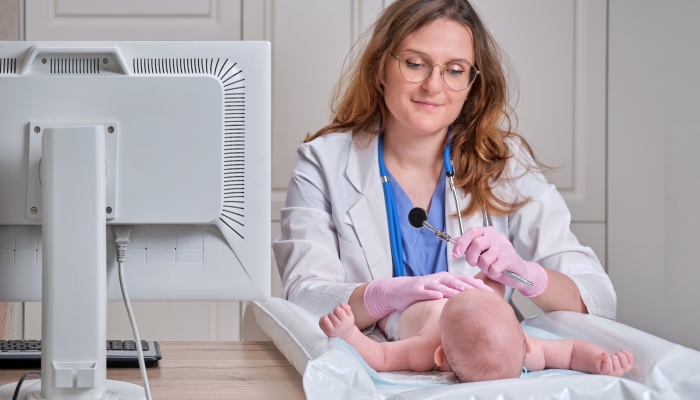
Babies should have their first dental visit by the time they’re one year old. Another rule of thumb is to have their first appointment no more than six months after you see their first tooth come in. I know it might seem like it’s way too early to start, but the truth is it’s critical to maintaining their first teeth.
Suchitra Nelson wrote in the study, Do baby teeth really matter? Changing parental perception and increasing dental care utilization for young children 1 1. Nelson, S., Slusar, M. B., Albert, J. M., & Riedy, C. A.. Do baby teeth really matter? Changing parental perception and increasing dental care utilization for young children. Contemporary Clinical Trials . 2017;59, 13–21. https://doi.org/10.1016/j.cct.2017.05.002 , that “Unlike other medical illnesses, childhood dental caries is entirely preventable with adequate self-management strategies by parent/caregivers that include regular preventive dental care and appropriate oral hygiene habits.”
This regular preventative dental care, Nelson states, allows the dentist the all-important task of checking your child’s teeth for tooth decay, pacifier teeth , defects, or anything that may require extra care or examination. Your baby’s first dental visit also establishes their dental care and begins getting them used to the process of dental visits.
How to Prepare for Your Baby’s First Dental Visit
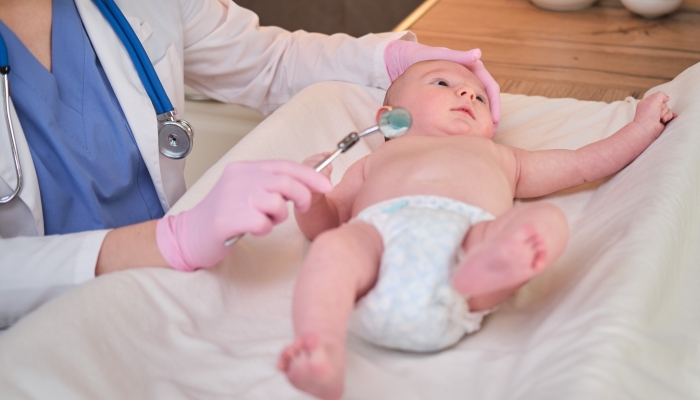
Preparation is key to a successful first dental visit. If you’re not sure where to start, here are some ideas of what you can do to help things go smoothly the day of:
- Find a Dentist: An obvious point, I know, but it’s worth mentioning for the simple fact that not all medical professionals are created equal. Find a pediatric dentistry with a good bedside manner that goes above and beyond to welcome your child.
- Talk It Up: This part is critical. Talking about going to the first appointment in an exciting way not only put my daughter in the right frame of mind, but it didn’t catch her off guard when the time came for us to go.
- Demonstrate the Process: If talking the process through isn’t interesting to them, try other resources like books or videos about the dentist. Seeing everything firsthand can be very disarming!
- Take a Tour: It’s always a great idea to take your child on a tour of the dental office; that way, their first time in the office isn’t on the day of their first appointment. They may take some comfort in the familiarity.
- Schedule Carefully: As with other appointments, things usually go better when your child is well-rested. Pick an appointment time either early in the morning after they wake or after a good long nap.
What to Expect During Your Baby’s First Dental Visit
At your child’s first dental visit, you can expect to be there for no more than 45 minutes. Their dentist will conduct a regular exam which includes checking your baby’s teeth for tooth decay, pacifier teeth, gum condition, and bite. If they think it necessary, they may do a gentle cleaning and polish too. Unless there’s an issue, you shouldn’t expect X-rays since their baby teeth will eventually fall out.
During this visit, the dental assistant and the dentist alike are great at getting your little one excited about maintaining their oral health, too, giving them a careful demonstration of cleaning techniques. This worked wonders with my daughter! She was all about trying to brush precisely how the dentist showed her after her first appointment.
Also, don’t be afraid to use this time to ask questions! Maybe you’re wondering why your baby’s teeth are coming through in the wrong order or how their thumb-sucking might affect their mouth over time. Now is the time to ask.
Tips to Help Your Baby Feel Comfortable During The First Dental Visit
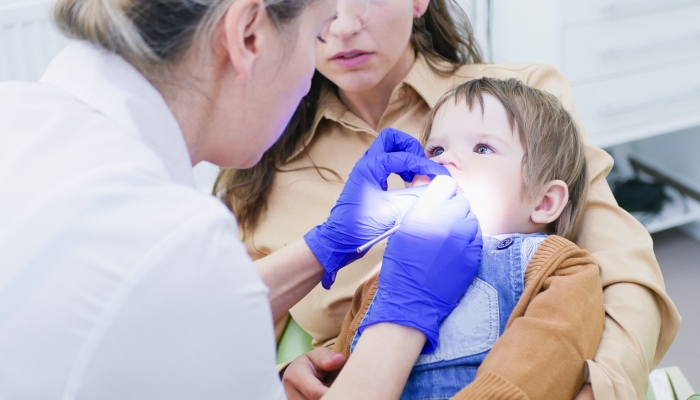
Your little one may feel a bit nervous during their first appointment, but there are plenty of ways you can make them feel comfortable from start to finish.
- Bring Comfort: If your little one has a favorite stuffed animal , blanket, or toy, consider bringing it along to the first appointment. It’ll bring them some comfort and maybe even act as a tool for demonstrating procedures to them.
- Be Positive: Babies often look to their parents to confirm whether or not certain situations are okay, reading their facial expressions and tone. Be a source of positive reinforcement with each step of the dental exam.
- Remind Them: If you prepared them for the appointment by explaining the process, reading a book, watching a video, or whatever you choose, remind them of those demonstrations. Recalling them might calm their nerves.
- Physical Touch: Whether their dentist allows your child to do a simple lap exam or they prefer them to sit in the dental chair, any physical separation can be distressing to them in a new scenario. Offer as much physical touch as you can, whether it be holding their hand or just keeping your hand on their arm or leg.
What are some signs that my baby may have dental problems that need to be addressed?
The easiest sign to spot would be a rejection of foods they usually enjoy or visible pain when they try to chew. Irritation from particularly hot or cold foods or drinks may also be a sign of tooth pain. Any swelling of the gums or jaw, tooth discoloration, bad breath, or even ulcers are all signs to consult your little one’s pediatric dentist as soon as possible.
How often should my baby have dental check-ups after the first visit?
As with adults, babies should continue to be seen every six months after their first dental visit. It’s essential to stick with that schedule even if your child receives good reports at every appointment. A missed dentist appointment could mean a missed issue that could have been easier to take care of from the get-go.
- Nelson, S., Slusar, M. B., Albert, J. M., & Riedy, C. A. (2017). Do baby teeth really matter? Changing parental perception and increasing dental care utilization for young children. Contemporary Clinical Trials , 59 , 13–21. https://doi.org/10.1016/j.cct.2017.05.002
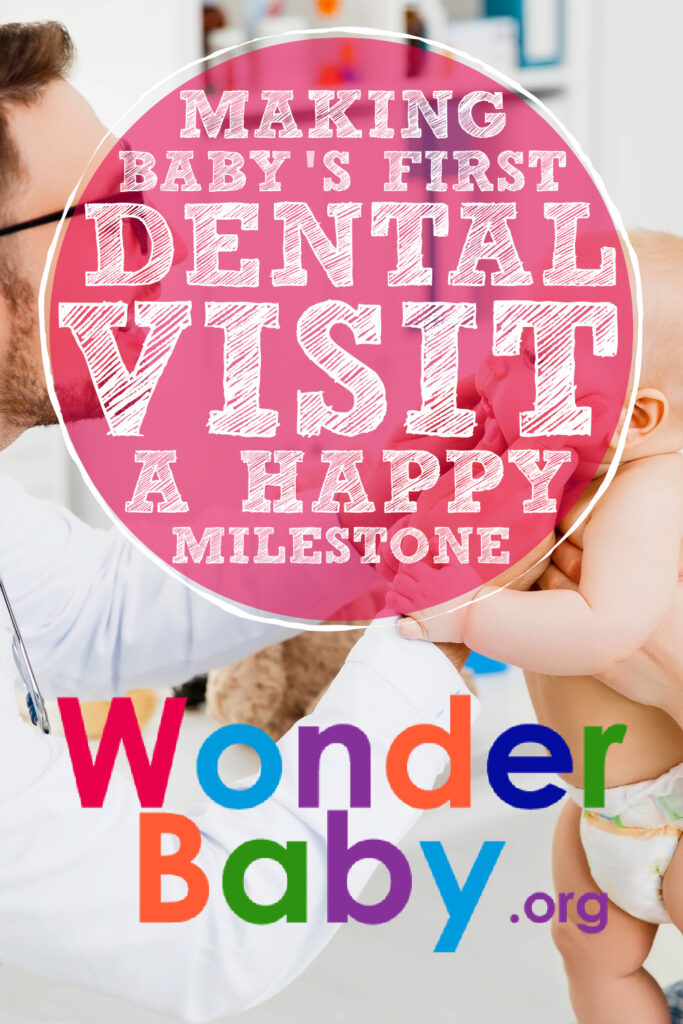
Related Posts
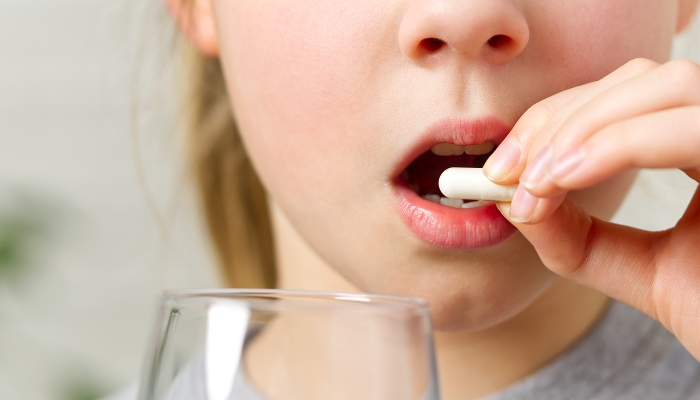
Health & Nutrition
Making Medicine Manageable: Teaching Kids To Swallow Pills
Teaching your child how to swallow a pill is an important skill as they grow older. Find out how to do it here.
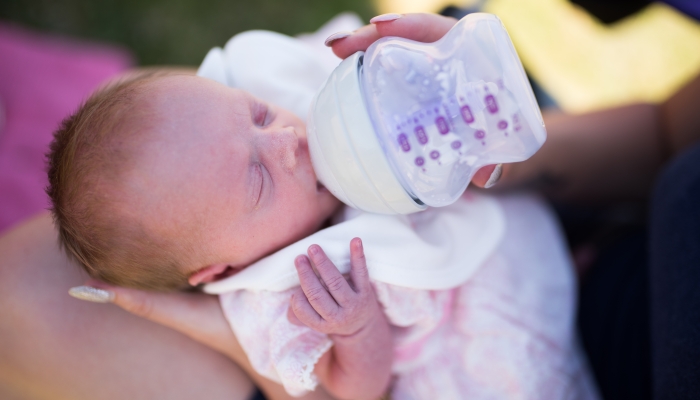
Feeding and Eating, Special Needs
Feeding Therapy Approaches for Infants with Special Needs
Many children with special needs have feeding difficulties. Working with a speech therapist, being patient, and experimenting with textures can help.
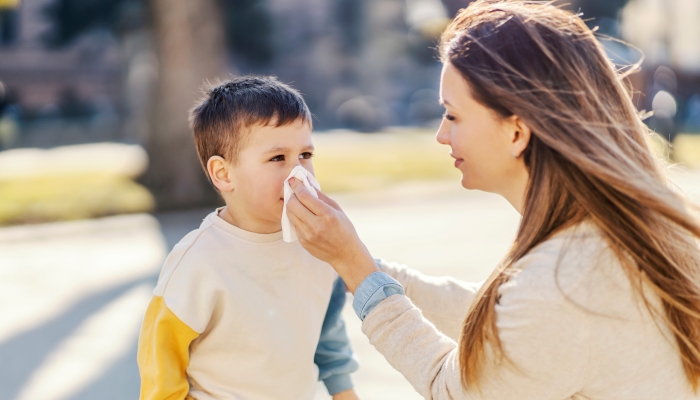
5 Tips for Managing Spring Allergies in Kids
Spring allergies can cause uncomfortable symptoms. The best way to navigate allergies in kids is to identify triggers and avoid exposure.
- Find-a-Dentist
Your Baby's First Dental Visit
Your baby is hitting new milestones every day, and his or her first dental visit is another one to include in the baby book!
Your child’s first dental visit should take place after that first tooth appears , but no later than the first birthday. Why so early? As soon as your baby has teeth , he or she can get cavities. Being proactive about your child’s dental health today can help keep his or her smile healthy for life. (Need a dentist? Use our Find-A-Dentist tool to find one in your area.)
How to Prepare
Moms and dads can prepare, too. When making the appointment, it can’t hurt to ask for any necessary patient forms ahead of time. It may be quicker and easier for you to fill them out at home instead of at the office on the day of your visit.
Make a list of questions, as well. If your child is teething , sucking his or her thumb or using a pacifier too much, your dentist can offer some advice.
What to Expect During the Visit
If your child cries a little or wiggles during the exam, don’t worry. It’s normal, and your dental team understands this is a new experience for your child!
Tips for a Great Visit
- Don’t schedule an appointment during naptime. Instead, pick a time your child is usually well-rested and cooperative.
- Make sure your child has had a light meal and brushes their teeth before their appointment so they won’t be hungry during their visit.
- Save snacks for after the visit so they aren’t on your child’s teeth during the exam.
- Think of the appointment as a happy and fun experience. If your child becomes upset during the visit, work with your dentist to calm your child. You’re on the same team!

The First Visit: What to Expect and How to Prepare Your Child?
The first dental visit is a crucial milestone in your child's oral health journey. It sets the foundation for a lifetime of good dental habits and helps ensure a healthy smile. However, it's natural for both children and parents to feel a little anxious about this new experience.
The key to a successful first dental visit is proper preparation. Discover essential tips on effectively preparing your child for this exciting dental adventure, ensuring they have a positive experience during their first dental visit.
What to Anticipate During Your Child's Initial Dental Visit?
During your child's first dental visit, there are several key components and procedures that you can expect. While the exact sequence may vary depending on the dental office and your child's age, here is a detailed description of what typically occurs during a child's first dental visit:
- Welcoming and Introduction : Upon arrival at the dental office, the dental team will warmly greet you and your child. The staff will create a friendly and welcoming atmosphere to help your child feel comfortable. They may offer a tour of the office, allowing your child to become familiar with the surroundings and dental equipment.
- Dental History and Medical Information : The dental team will ask you about your child's dental and medical history before the examination. They will inquire about any concerns you may have about previous dental treatments and your child's oral hygiene routine. Providing accurate information to ensure personalized care for your child is essential.
- Oral Examination : The dentist will perform a comprehensive oral examination of your child's mouth. This examination allows the dentist to assess the overall health of your child's teeth, gums, jaw, and oral tissues. Depending on your child's age and cooperation level, the dentist may use a dental mirror, a small probe, or other gentle instruments to examine the teeth and gums.
- Teeth Cleaning : In most cases, the dental hygienist or dentist will use a gentle teeth cleaning, also known as prophylaxis. Using specialized tools, they will remove plaque, tartar, and any surface stains from your child's teeth. The cleaning process may involve a high-powered toothbrush, flavored toothpaste, and a scaling instrument to ensure a thorough cleaning.
- Dental X-rays (if necessary): Dental X-rays provide a more detailed view of the teeth's structure and help detect hidden dental problems, such as cavities or impacted teeth.
- Fluoride Treatment : After the teeth cleaning, you may expect fluoride treatment on your child's teeth. Fluoride therapy helps strengthen your child's teeth and protect against tooth decay. The fluoride solution is usually used as a gel, foam, or varnish and is brushed onto the teeth or placed into a tray that your child bites down on for a short period. It is a quick and painless procedure that helps in preventing cavities.
- Oral Hygiene Instructions and Education : The dentist will provide dental hygiene instructions tailored to your child's age and development. He may also address common concerns like teething, thumb-sucking, and pacifier use, offering guidance on managing them effectively.
- Discussion and Next Steps : At the end of the visit, the dentist will discuss his findings, address any concerns you may have, and recommend any necessary follow-up treatments or appointments. The dentist will also guide how often your child should visit the dentist for routine check-ups and cleanings, emphasizing the importance of regular dental care.
“The child’s first dental visit, according to pediatric dentists, should occur within six months after the eruption of their first tooth or by their first birthday, whichever comes first. However, around 48% of the parents in the United States delay their child’s first dental visit until the age of two or older, which is later than the recommended age”.
Why Preparing Your Child for the First Dental Visit is Important?
Preparing your child for his first dental visit sets the stage for a positive and successful experience. Preparation for the first dental visit is essential for several important reasons:
Reducing Anxiety and Fear : Dental visits can be unfamiliar and intimidating for children, especially if they have never been to a dentist. Preparing your child in advance can help alleviate his anxiety and fear of the unknown.
Establishing Trust and Building Rapport : A successful dental visit depends on trust and a positive relationship between your child and the dental team. Preparing your child beforehand will allow him to become acquainted with the dental environment, meet the dentist, and interact with the dental staff. This familiarity helps build trust and rapport, enabling your child to feel more comfortable and cooperative during the visit.
Creating Positive Dental Attitudes and Habits : The first dental visit sets the tone for your child's attitude towards dental care in the future. Preparing him in advance can instill a positive perception of dentistry.
Facilitating Effective Communication: When children feel comfortable expressing themselves, dental professionals can address their questions, provide appropriate explanations, and tailor their approach. Effective communication helps create a supportive and collaborative environment and meets your child's needs during the dental visit.
Promoting Cooperation and Compliance : Children who know what to expect are more likely to cooperate during dental visits. Explaining and demonstrating the procedures through role-playing or age-appropriate resources can help your child understand the importance of following instructions, sitting still, and cooperating with the dental team. This cooperation ensures a smooth and efficient examination and treatment process.

Tips to Prepare Your Child to Meet the Dentist
Start Early : Introduce your child to visiting the dentist as a positive and essential part of caring for his teeth and keeping a healthy smile.
- Use Positive Language : When discussing the dental visit, use positive and reassuring language. Avoid using words like "pain," "hurt," or "shot." Instead, focus on explaining that the dentist will check your child's teeth, count them, and ensure they are strong and healthy.
- Read Books or Watch Videos : Use children's books or age-appropriate videos about visiting the dentist to make it more relatable and fun for your child. These resources can help familiarize your child with what to expect and ease the anxieties.
- Role Play : Set up a pretend dental visit at home by taking turns being the dentist and the patient. Use a toothbrush and mirror to demonstrate how the dentist will count and examine your child's teeth. This interactive playtime can help your child become more comfortable with a dental visit.
- Visit the Dental Office in Advance : Take your child for a short visit to the dental office before their appointment. It will allow him to see the waiting room, meet the dental staff, and become familiar with the environment. This familiarity can reduce anxiety on the day of the actual visit.
- Explain the Steps : Talk your child through the steps involved in a dental visit, such as checking his teeth, cleaning, and possibly taking X-rays. Use simple and age-appropriate explanations to help him understand what will happen during the appointment.
- Share Your Experiences : Share positive experiences from your dental visits to help reassure your child. Talk about how the dentist and dental team were friendly and how you felt after caring for your teeth.
- Encourage Questions : Let your child know it's okay to ask questions during dental visits. Assure him that the dentist and dental team are there to help and answer any concerns.
- Discuss Rewards: Talk about the potential rewards or treats your child may receive after his dental visit. It will motivate your child and make the experience more exciting.
- Be a Role Model : Show your child that dental visits are crucial by regularly attending your dental appointments. Let your child see that you value oral health and that visiting the dentist is a normal part of life.
Final Thoughts
Inspire your child to embrace the first dental visit as an exciting adventure where he can learn about the importance of oral hygiene, receive professional care, and take pride in their beautiful smile. As you prepare your child for his first dental visit, remember that every child is unique, and the reactions may vary.
Patience, understanding, and support are chief factors during this process. With your guidance and the expertise of a pediatric dentist, your child's first dental visit can be a positive step towards a lifetime of happy and healthy smiles. Make the first dental visit a memorable and successful experience for your child to instill a positive attitude towards dental care.
Contact Stockton dentist for kids , Sajjad Rizvi DDS, at Happy Kids Dental to know about the First Visit: What to Expect and How to Prepare Your Child.
Importance of Pediatric Dentistry for Kids
*This media/content or any other on this website does not prescribe, recommend, or prevent any treatment or procedure. Therefore, we highly recommend that you get the advice of a qualified dentist or other medical practitioners regarding your specific dental condition*
Share This Post
Subscribe To Our Newsletter
Get Updates And Learn From The Best
More To Explore
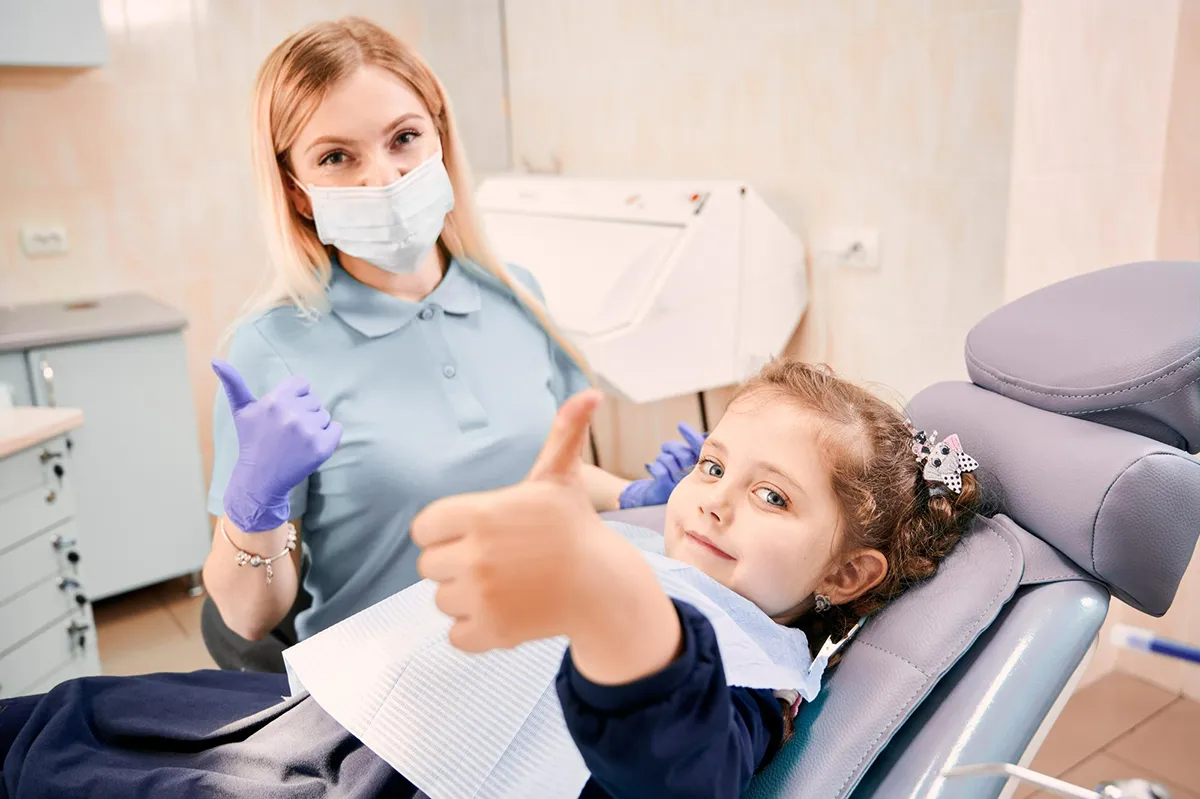
Orthodontic Awareness: Recognizing Signs of Orthodontic Issues in Children
Orthodontic issues during childhood can significantly impact oral health, influencing aesthetics and teeth and jaw functionality.
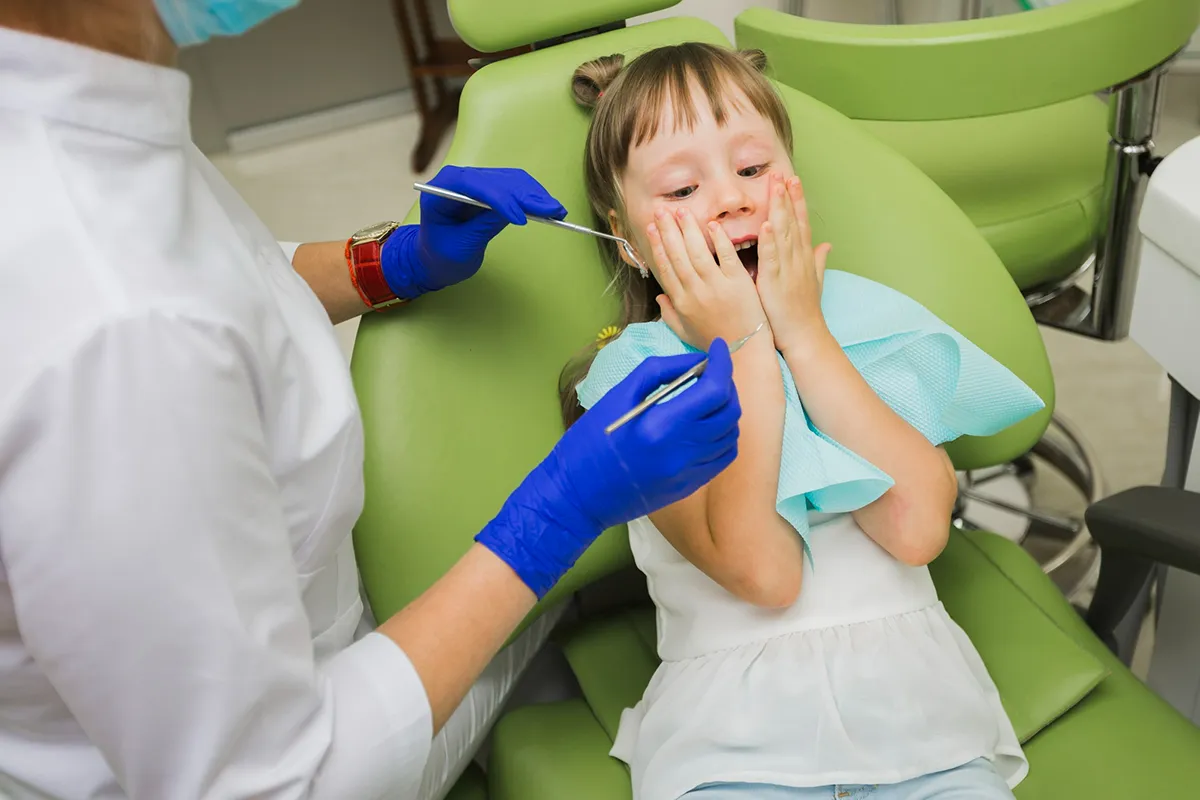
Managing Children’s Dental Anxiety
Incorporating supportive strategies, such as gradual exposure, positive reinforcement, and transparent communication, is crucial in easing children's dental anxiety.

- My member dashboard
- Edit your profile
- Change your password
- My dentist dashboard

Your child’s first dental visit
A child’s first visit to the dentist is an exciting milestone. But it’s also an important appointment that can help set them on a lifelong path toward good oral health.
The right time to schedule a first visit is within six months of their first tooth coming in, or no later than their first birthday. This timing is crucial because it’s important to:

Learn how to help your child avoid cavities and reduce health risks.
Find out who to call if there is an emergency.
Get to know your child’s dentist.
In the long run, you’ll also save money by learning how to take care of your child’s oral health and reducing the risk of more serious or expensive issues.
Getting your child ready
In advance of the visit, give them an idea of what to expect:
Go over what will happen at the appointment (more on that below). And be sure not to pass on any personal fear you may have of dentists to your child. Give them every opportunity to enjoy their first visit.
Explain why it’s important to go to the dentist and how it keeps them healthy.
Take time to answer any questions they may have.
Try to schedule a morning appointment when your child is likely to be more awake and attentive.
The day of the visit, go over what to expect one more time. Don’t share any negative experiences that you or other family members may have had with the dentist – instead, remain calm and positive! Your child will likely mirror the feelings you express about the appointment.
It can help to bring a comfort item or quiet game so they can have a little fun while they wait. It’s also an option to plan a positive reward for after the appointment.
What will happen during the visit?
During the routine exam, the dentist will check your child for cavities and review overall growth and development. The dentist will also demonstrate how to properly brush and floss your child’s teeth at home to make sure you’re as effective as possible in removing the plaque bacteria from all tooth surfaces.
To help you continue to care for your child’s oral health, you and your dentist will also:
Discuss food, drinks, and habits that can cause cavities and healthy alternatives
Review the vital role fluoride plays in strengthening tooth enamel and protecting your child’s smile
Be given helpful information for preventing accidents as your child grows
Why is it important to practice good oral health care from an early age? Because untreated oral health issues will continue to worsen over time – and more than half of children ages 6 to 8 have had a cavity in at least one baby tooth. 1
By taking your child to the dentist, you’re pointing them toward the path of good oral health. Prepare a little in advance to make sure it’s a great appointment!
1 Centers for Disease Control and Prevention
- Patient Portal
- Is Your Child Sick?
- Infant Dosage Charts
- Talk with a Doc: New Parent Classes
- Healthy Recipes
- Safety Handouts
- Infant Articles & Tips
- All About Newborns
- Infant Nutrition Questions
- Breastfeeding
- Visit Schedule
- Teen Questionnaires
- Handouts & Resources
- Utah Immunization Schedule
- Immunization Handouts
- Parenting Handouts
Recommended Reading
- Educational Handouts
- Surveys and Questionnaires
- Fall/Winter Tips
- Spring/Summer Tips
- Find a Pediatrician
- Emergency Numbers
- After Hours
- Administrative Forms
- Plan Your First Visit
- Accepted Plans
- Insurance FAQs
- Common Financial Misperceptions
- Financial Policy
- Glossary of Terms
- Contact Billing Office
- Frequently Asked Questions
- Pediatrician Directory
- Affiliated Utah Hospitals
- Employment Opportunities
- Privacy Practices
- Notice of Nondiscrimination
- Leave a Review
- Childhood Immunizations
- Referral Contest
Home » Topics » When should my toddler have their first dental visit?
When should my toddler have their first dental visit?
Article at a Glance
- Dental care should begin as early as a child’s first birthday or within six months after their first tooth appears.
- There are several benefits to seeing a pediatric dentist rather than a general dentist.
- Early dental visits help treat problems early on and help prevent dental issues in the future.
As a new parent, you want to ensure your baby is healthy and happy. One crucial aspect of your baby’s health is their dental health. But, since babies arrive with many needs and without a full set of teeth, dental care can be an easy step to overlook.
When should my baby’s first dental visit be?
The American Academy of Pediatric Dentistry and the American Academy of Pediatrics both recommend that children see a dentist by their first birthday, or within six months after their first tooth appears. This may seem early, but it’s important to establish good dental habits from a young age. A pediatric dentist can also check for any potential dental problems and provide guidance on how to care for your baby’s teeth.
Does my baby need to see a children’s dentist or a general dentist?
The most important part is that you see a dentist. But, there are several benefits to seeing a pediatric dentist instead of a general dentist for your child’s dental care.
Specialists in Children’s Dentistry
Pediatric dentists receive two to three years of additional training after dental school that focuses on the unique dental needs of infants, children, and adolescents. They are specifically trained to work with children, including those with special needs, to provide a comfortable and positive dental experience.
Child-Friendly Environment
Pediatric dental offices are designed to be child-friendly, with bright colors, toys, and games in the waiting room to help children feel comfortable and relaxed. The dental chairs and equipment are also designed with children in mind, making the dental experience less intimidating.
Preventive Care
Pediatric dentists focus on preventive care, such as fluoride treatments and dental sealants, to help children avoid tooth decay and other oral health problems. They also advise on good oral hygiene practices and diet choices to help children develop healthy habits for life.
Early Detection and Treatment of Dental Problems
Pediatric dentists are trained to detect and treat dental problems early, before they become more serious and require more extensive treatment. They can also provide early intervention for orthodontic issues, helping to ensure proper dental development and preventing more significant problems later on.
Education and Support for Parents
Pediatric dentists work closely with parents to educate them about their child’s oral health and provide guidance on proper dental care at home. They can also support parents with concerns about their child’s dental development or their behavior during dental appointments.
Why Dental Checks are Important
Regular dental check-ups are essential for everyone, regardless of age. For babies, seeing a dentist early can help prevent future dental problems. Those little baby teeth play an important role in developing adult teeth. They help your baby chew and speak and also hold the space for adult teeth to grow in properly. If baby teeth are lost too early due to decay or injury, it can cause problems with the development of adult teeth.
Seeing a dentist early can also help establish good dental habits. A pediatric dentist can provide guidance on how to clean your baby’s teeth and gums and provide information on proper nutrition and fluoride usage. By establishing good habits early on, you can help ensure your baby’s dental health as they grow older.
What can we expect during my baby’s first dental visit?
During your baby’s first dental visit, the dentist will likely do a quick exam to check for any potential issues. They may also guide you on brushing and flossing techniques appropriate for your child’s stage of dental development. Finally, the dentist will likely clean your baby’s teeth and offer fluoride treatment.
If you’re visiting an office specializing in kids, chances are good that your child will leave with a smile, a prize, and a positive memory of the visit.
In conclusion, your baby probably needs to see a dentist earlier than you might have thought. If you prefer to see a generalist, it’s not the end of the world. But if you or your child have complex dental issues or anxiety around dental visits, starting with a children’s specialist may be the smart move.
Be sure to check out these dental articles as well: Taking Care of our Children’s Teeth What should I do if my child has a dental injury?
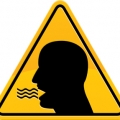
Stay connected to your children’s health:
Want pediatric news, kid-friendly recipes and parenting tips? Sign up for our patient parent newsletter:
Other great ways to connect:
- Is My Child Sick?
- Medical Conditions
- Healthy Living
- Child Safety
- Special Needs
- Immunization
- Well-Child Visits
- Parenting Tips
- Surveys & Questionnaires
- Pediatric News
- All Pediatricians
- American Fork
- Cherry Tree
- Orem Timpanogos
- Provo North University
- Mapleton Pediatricians
- Spanish Fork
- Saratoga Springs
- Financial Misperceptions
- Pediatrician Dictionary
- Privacy Policies
- Online Services Privacy Policy
- Terms of Use
- Quality Outcomes
The NCQA is a private, nonprofit organization dedicated to improving health care quality. Learn more.


Start earning CE Units in minutes!

A Child’s First Dental Visit
An exploration of why the age 1 visit is a game changer in terms of overall oral health and childhood caries.
EDUCATIONAL OBJECTIVES
After reading this course, the participant should be able to:
- Explain the concept and value of a dental home and the Age 1 dental visit, as well as utilization rates for this model of care.
- Describe fundamental clinical practices and challenges when caring for infants and young children.
- Detail key issues surrounding childhood caries and the need to educate parents and caregivers of young pediatric patients.
For the better part of the last 100 years, dentistry followed the “see and treat” concept; meaning that oral health care was, for the most part, treatment oriented. Dentists did what they were trained to do, which was to treat dental caries. Most patients visited the dentist to address a specific problem (usually prompted by the occurrence of pain). Many did not consider primary teeth important, since they were looked upon as being transitional, and would soon be exfoliated and replaced by permanent teeth. In fact, in the 1950s some dental offices had signs in their waiting rooms proclaiming, “No children under age 13 treated.”
With an increase in the knowledge of the dental caries process, dentists gradually began to see children at earlier ages. Many dentists were ill equipped to communicate with and/or treat such young patients; consequently, the recommended age for the child’s first dental visit was on or after the 3rd birthday. Dentistry for patients under the age of 3 was largely approached didactically and not clinically. Prevention of dental disease for this group was a mere afterthought.
PARADIGM SHIFT
Once dental caries was understood as a chronic bacterial disease with a behavioral component, the paradigm shifted from treating the resulting damage to addressing the cause (prevention). In turn, this shift had a significant impact on determining the optimal age for the first dental visit.
Dentistry will never “drill its way out” of the early childhood caries (ECC) epidemic. For practitioners to succeed in the fight against ECC, they must improve preventive efforts and manage lesions in their earliest stages. A patient’s risk of developing dental caries starts with the introduction of oral pathogens into an infant’s mouth; therefore, first seeing the dentist at age 3 could prove too late. The age 1 visit not only allows for preventive therapies and early treatment, it also benefits the child by helping to establish optimal feeding and oral hygiene habits.
In a 1992 policy statement, the American Academy of Pediatrics proposed a definition of the medical home and referred to the “delivery of advanced primary care, with the goal of addressing and integrating high quality health promotion, acute care, and chronic condition management in a planned, coordinated and family centered manner.” 2 In 2001, the AAPD adopted its Policy on the Dental Home, based on the American Academy of Pediatrics’ medical home concept. Children who have a dental home are more likely to receive appropriate and routine preventive care and thus have a reduced risk of dental disease. 3
The recommendation for a child’s first dental visit to occur at or before age 1 has been the standard since 2001. Yet, practically speaking, dentistry for patients under the age of 3 continues to be largely spoken of didactically, and not widely implemented clinically in general practice. This is not a criticism as much as an observation. Dentists are busy addressing the functional and physical effects of dental caries and have little time to address the process. Many have not been adequately trained to understand the purpose and method of introducing the age 1 patient to clinical practice. This article will explain the rationale, benefit and technique for implementing the age 1 dental visit. The goal is to make dental practitioners comfortable and competent in meeting this standard of care.
RATIONALE FOR EARLY CARE
Dental caries is a preventable, chronic disease that is influenced by social and behavioral factors. Improving access to — and the use of — preventive and disease management strategies, along with early dental visits, will contribute to better patient outcomes, reduction of per capita health care expenses, and improved utilization of services.
According to research, annual treatment costs for children who had their first dental visit by age 1 are significantly less than for patients who wait until they are older. 4 Children seen by a dentist before age 1 are more likely to see the dentist on an ongoing basis, and less likely to require restorative or emergency visits. By comparison, those seen for the first time at age 2 and age 3 have an increased need for preventive, restorative and emergency visits over time. 5
Unfortunately, 23% of children continue to experience dental caries, with children from ages 2 to 5 experiencing increasing rates. 6 In 2015, 57% of children on Medicaid did not receive preventive oral health services. 7 Previous research showed that Medicaid patients ages 1 to 5 accounted for 45% of total dental costs, even though this age group represented only 5% of the insured population. 6 In a 2015 retrospective review of privately insured patients, only 1% had their first dental visit by age 1. 8
It is logical to ask, “If so much could be done to enhance oral health with effective preventive strategies implemented in the first year of life, why hasn’t dentistry been more effective in this regard?” This is a good question with a complex answer.
Seldom is a patient under the age of 3 cooperative in the dental office. If the dentist’s role is only restorative, there is a dilemma of how to perform complicated procedures on kicking, screaming and crying patients. In years past, many dentists were ill prepared to cope with such patients, therefore treatment was delayed until after the patients were better able to cooperate, usually after their 3rd birthday.
Only recently have the age 1 visit, the value of a dental home, and the clinical skills to complete an infant oral examination been emphasized in dental school curricula. While practicing general dentists may have been exposed to these concepts, as previously noted, many have not been trained in the delivery of care for such young patients.
In addition, dentists are trained to diagnose and restore the consequences of dental disease. Far too often, dentistry is viewed as a surgical specialty, and the schedules of many dentists are customarily filled with patients having broken-down teeth needing immediate attention. If this pattern is to be reversed, there must be a complete paradigm shift emphasizing preventive care and, when possible, nonsurgical management.

THE THREE PILLARS
A proper infant oral examination visit rests upon three pillars:
- Risk assessment
- Oral examination
- Anticipatory guidance
Risk Assessment: Effective infant preventive dentistry begins with an assessment of individual risk factors, as established through the medical, social and dental histories (Table 1). Preventive strategies are subsequently developed to address the patient’s specific risk. These activities occur before the patient’s oral exam and are aimed at providing the primary caregiver with adequate information to reduce the risk of dental caries.
Special attention should be given to the primary caregiver’s dental history. The infant’s oral pathogens are the result of vertical transmission from the primary caregiver. Untreated caries and high bacterial counts from periodontal conditions in the caregiver’s mouth result in the infant having a bacterial flora conducive to caries development. 9
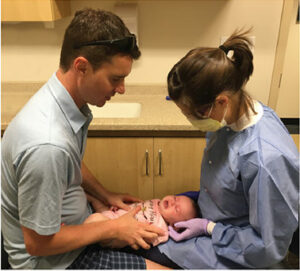
Feeding habits affect caries risk through both what is eaten, and how it is eaten. Carbohydrate-rich diets are highly cariogenic and should be limited. Feeding on demand and/or at night leads to what was formerly referred to as “baby bottle decay,” but now is now known as ECC. 10 The American Academy of Pediatrics recommend infants be breastfed until age 1. 11 Breastfeeding or bottle-feeding should not be ad lib. Feeding at night increases the risk of caries formation. During sleep, the body’s systems slow and respirations and the heart rate decreases. There is also reduced salivary flow, and this diminishes the natural cleaning and buffering effect of saliva.
Oral Examination: The examination of the infant’s oral cavity takes place in a knee-to-knee fashion (Figure 1). The dentist cradles the infant’s head in his or her lap while supporting the head. The caregiver holds the infant’s hands and feet. It is normal and beneficial for the infant to cry, as this ensures the mouth is open and an adequate visual examination is possible. The dentist should communicate throughout the examination and remain complimentary of the infant and caregiver. Clinical observations should be pointed out, and the provider should demonstrate proper technique for cleaning the teeth using a gauze, toothbrush or washcloth. Finally, fluoride varnish should be applied. (Additional clinical resources are found in Table 2.)
Anticipatory Guidance: In terms of diet and feeding habits, breastfeeding should be encouraged and added carbohydrates avoided. Feeding should be on a schedule and infants should never be put to bed with a bottle. Water after feeding should also be encouraged.
The child should be introduced to toothbrushing when the first tooth erupts. A soft-bristle brush with an age-appropriate amount of fluoridated toothpaste is recommended (refer to the AAPD’s guideline on fluoride use). As noted, the dentist should demonstrate the technique to the caregiver during the knee-to-knee examination. Other sources of fluoride include drinking fluoridated water and use of fluoride varnish, which should be placed on primary teeth at each dental visit.
TOOTH ERUPTION
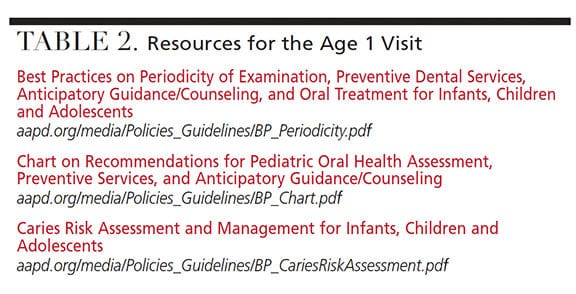
NONNUTRITIVE HABITS
Nonnutritive oral habits are common in infants. The caregiver should be assured these are normal and that most infants discontinue them in time. Persistent habits that are causing distortion of the oral cavity can be addressed when the patient is mature enough to want to quit. Until then, the dentist should monitor the habit and any resulting oral changes it is causing.
RECALL VISITS
High-risk patients should be placed on a three-month recall schedule. Fluoride varnish should be applied at these visits. Additional anticipatory guidance information should be reemphasized at each appointment. More information on the infant examination can be found in the AAPD Guideline for Infant Oral Health Care ( aapd.org/ media/ Policies_ Guidelines/ G_ InfantOralHealthCare.pdf ).
Dentists who provide care for pediatric patients are highly encouraged to adopt the age 1 visit. It is the standard of care for young patients and supported by the AAPD, American Dental Association and American Academy of Pediatrics. While preventive measures are important for all patients, waiting to institute these measures at age 3 would be too late for patients at high risk of dental caries. The patient with ECC will require more dental care, incur more expense, and is likely to face a lifetime of caries. For dentistry to address this dilemma in any significant way requires intervention upon the eruption of the first primary tooth.
Just as pediatricians are the primary medical care providers for infants, dentists are the primary oral health care providers for this patient population. The role and responsibility of the dentist is to provide education and training to the parents/caregivers and, when appropriate, the child, too. The value of the child’s first dental visit, and subsequent routine appointments, is not merely the dental prophylaxis. It is the supervision and educational information the parent/caregiver and patient receives from the dental team that will provide a lifetime of value in terms of oral and overall health.
- American Academy of Pediatrics. Maintaining and improving the oral health of young children. Section on oral health. Pediatrics. 2014;134:1224–1229.
- American Academy of Pediatrics. Medical Home definition. Available at: https://www.aap.org/en-us/professional-resources/practice-transformation/ medicalhome/Pages/home.aspx. Accessed January 17, 2019.
- American Academy of Pediatric Dentistry. Definition of Dental Home. Available at: http://www.aapd.org/ media/policies_guidelines/d_dentalhome.pdf. Accessed January 17, 2019.
- Dye BA, Thornton-Evans G, Li X, Iafolla TJ. Dental caries and sealant prevalence in children and adolescents in the United States, 2011–2012. NCHS Data Brief . 2015;191:1–8.
- Nowak A, Christensen JR, Mabry TR, Townsend JA, Wells MH. Pediatric Dentistry: Infancy through Adolescence . 6th ed. Philidelphia: Saunders; 2018:137.6.
- Lee JY, Bouwens TJ, Savage MF, Vann WF Jr. Examining the cost-effectiveness of early dental visits. Pediatr Dent . 2006;28:102–105.
- Casamassimo PS, Hammersmith K, Gross EL, Amini H. Infant oral health: an emerging dental public health measure. Dent Clin North Am . 2018;62:235–244.
- Kolstad C, Zavras A, Yoon RK. Cost-benefit analysis of the age one dental visit for the privately insured. Pediatr Dent . 2015;37:376–380.
- Dye BA, Vargas CM, Lee JJ, Magder L, Tinanoff N. Assessing the relationship between children’s oral health status and that of their mothers. J Am Dent Assoc . 2011;142:173–183.
- Kierce EA, Rainchuso L. Comprehensive approach to early childhood caries. Decisions in Dentistry. 2017;3(12):34–36,39.
- The American Academy of Pediatrics Policy on Breastfeeding. Available at: https://www.aap.org/en-us/advocacy-and-policy/aap-health-initiatives/ Breastfeeding/Pages/AAP-Policy-on-Breastfeeding.aspx. Accessed January 17, 2019.
Featured image by ONDROOO/ISTOCK/GETTY IMAGES PLUS
From Decisions in Dentistry. February 2019;5(2):30—32,35.
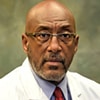
Orpheus L. Triplett, DDS, is an associate professor in the Department of Pediatric Dentistry and Community Oral Health at the University of Tennessee Health Science Center College of Dentistry, where he serves as director of Community Relations and Outreach. Triplett has more than 20 years experience in private practice and has also served as dental director for Christ Community Health Services, a multisite federally qualified health center in Memphis.

Larry Dormois, DDS, MS, is chair of Pediatric Dentistry and Community Oral Health at the University of Tennessee Health Science Center College of Dentistry in Memphis. Board certified by the American Board of Pediatric Dentistry, he is also a fellow of the American Academy of Pediatric Dentistry and American College of Dentists. Dormois serves as an examiner for the American Board of Dentistry and is a site visitor for the Council on Dental Accreditation with the American Dental Association. He can be reached at [email protected].
Risk Factors in Oral Cancer Screening
Asthma’s Effects on Oral Health
Nutritional Counseling in the Dental Setting
Clinical Applications of Soft Tissue Augmentation Around Implants
A Comprehensive Review of Clear Aligner Therapy
Improving Access to Care for Patients With Autism Spectrum Disorder
Brushing is should start as soon as teeth appear, which can be as early as 4 months. Babies usually get bottom teeth first, then top ones. Don’t get too worked up about when baby teeth come in.
Your email address will not be published.
Save my name, email, and website in this browser for the next time I comment.
This site uses Akismet to reduce spam. Learn how your comment data is processed .
- Advertisement -
decisionsindentistry

This website uses cookies to improve your experience. We'll assume you're ok with this, but you can opt-out if you wish. Accept Read More
Get Your FREE Local Anesthesia Tables!
Join our email list to download your free printable tables on local anesthesia, including: contraindications, allergies, impact of systemic health, anesthetic agents, and MRD for kids.
Please check your email and click the confirmation button so we can send you your free tables!
Username or Email Address
Remember Me

Welcome, Login to your account.
Recover your password.
A password will be e-mailed to you.
An official website of the United States government
The .gov means it’s official. Federal government websites often end in .gov or .mil. Before sharing sensitive information, make sure you’re on a federal government site.
The site is secure. The https:// ensures that you are connecting to the official website and that any information you provide is encrypted and transmitted securely.
- Publications
- Account settings
Preview improvements coming to the PMC website in October 2024. Learn More or Try it out now .
- Advanced Search
- Journal List
- Healthcare (Basel)

Preparing Children for Their First Dental Visit: A Guide for Parents
Simone bagattoni.
1 Unit of Special Needs Dentistry and Paediatric Dentistry, Department of Biomedical and Neuromotor Sciences, University of Bologna, 40125 Bologna, Italy
2 Unit of Pediatric Dentistry, Department of Surgical, Medical and Molecular Pathology and Critical Care Medicine, University of Pisa, 56126 Pisa, Italy
Francesca Nascimben
Elena biondi, raquel fitzgibbon, lisa lardani, maria rosaria gatto, gabriela piana, katia mattarozzi.
3 Department of Experimental, Diagnostic and Specialty Medicine, University of Bologna, 40126 Bologna, Italy
Associated Data
The data presented in this study and the information booklet are available on request from the corresponding author.
The aim of the study was to test an information booklet containing suggestions to parents on how to prepare their child for the first dental visit. Forty-five children and one parent per included child took part in the trial. Children were randomized in two groups; the information booklet was e-mailed to the parents of the study group. At the end of the visit, the dentist and the parent evaluated the child’s behavior through the Frankl Behavior Rating Scale (FBRS) and the utility of the booklet through a Likert scale. The children evaluated the pleasantness of the visit and the perceived pain through the Wong–Baker FACES ® Pain Rating Scale (WBFPRS). Parents evaluated the information booklet as highly understandable and useful. According to the dentist, informed children were more cooperative (FBRS median score: 4; IQR: 3.5–4) than the control group (median score 3; IQR: 2–4) ( p = 0.013; Mann–Whitney U test). Children prepared with the booklet reported less pain (WBFPRS: 0.40 ± 0.82 vs. 1.42 ± 1.99; p = 0.034; t -test;) and tended to evaluate the visit as more enjoyable (WBFPRS: 1.1 ± 2.14 vs. 2.75 ± 3.43; p = 0.064; t -test) than unprepared children. The information booklet increases the child’s ability to cooperate during the visit and could represent a useful instrument for the clinical practice.
1. Introduction
In medicine and dentistry, the treatment’s effectiveness derives not only from the competence of the physician but also from the ability to create an effective relationship with the patient. When the patient is a child or a special-needs patient, the relationship is more complex [ 1 , 2 ]. The dentist has a dual task: to deal with the child’s possible resistance arising from fear of the unknown and potentially threat; to deal with parents’ behavior, often unprepared to adequately guide their child toward dental care [ 3 ]. Obtaining the child’s and parents’ cooperation, while promoting a positive attitude toward dental care, is a primary goal for the pediatric dentist [ 4 ].
In this context, preoperative communication is very useful, but often underestimated. Many studies have shown how the information children receive about the dental environment before the visit can influence their behavior, both positively and negatively. A previous study showed that presenting pictures of children enjoying the dental visit promotes a positive relationship with the dentist [ 5 ]. The study showed a reduction in anticipatory anxiety, the unpleasant sensation that afflicts children during their first dental experience [ 5 ]. The study by Melamed et al. [ 6 ] showed that children that were previously prepared for restorative procedures watching a video of a peer undergoing the same procedure can overcome their fears and be more cooperative. The children of the control group, who were shown a video with nondental content, reported a higher level of anxiety.
Even though the child acquires information of the therapy’s steps and instruments, they have never experienced them directly; thus, they can be frightened of what they will feel. It is, therefore, necessary to provide preparatory sensory information; this helps the child to cope with fear and pain, especially when combined with the use of distraction. Distraction alone may not be enough if the child, unaware of what will come, is tense and unable to distract themself; the prepared child knows what awaits them and is more easily distracted [ 7 , 8 ]. As shown in several studies, the parent’s state of anxiety greatly influences that of the child; hence, the preparatory information is also useful for reassuring the parent [ 9 ].
To date, not enough attention has been paid to the role of communication before the first dental visit to encourage the child’s cooperation and avoid dysfunctional behaviors. The dentist can provide parents with the information they need to adequately prepare the child for treatment. The present study aimed to investigate the effectiveness of an information booklet to promote pediatric patients’ cooperation during the first dental visit. We hypothesized that offering guidance to parents on how to prepare their children for the first visit would (I) reduce the degree of unpleasantness of the visit for children, (II) reduce the child’s pain perception, (III) increase the child’s cooperation, and (IV) be appreciated by parents.
2. Materials and Methods
This was a single-center parallel-group study. We adopted a single-center approach to guarantee consistency regarding equipment, environment, and data collection. The study took place at the Unit of Pediatric Dentistry of the Department of Biomedical and Neuromotor Sciences of the University of Bologna.
The study design was approved by the Ethics Committee of Area Vasta Emilia Centro (CEAVEC) on 23 January 2019 (protocol No. 0033664, ref 69/2019/SPER/AUSLBO) and registered on ClinicalTrial.gov ( {"type":"clinical-trial","attrs":{"text":"NCT05608720","term_id":"NCT05608720"}} NCT05608720 ).
2.1. Sample Size
Preliminary results from a pilot study carried out by the same scientific committee (not published data) evidenced an average of visit pleasantness rated by children equal to 0.9 in the study group and 2.7 in the control group. Consequently, at an alpha level equal to 0.05 with a power of 80% for a two-sided test and an allocation ratio of 1:1 between the two groups, a sample size of at least 21 children was needed in each group.
2.2. Recruitment and Randomization
Eligible participants were parents and their children who made an appointment for a first visit at the Unit of Pediatric Dentistry of the Department of Biomedical and Neuromotor Sciences of the University of Bologna between January 2019 and September 2019. The parents of 158 children were initially contacted by telephone by the principal investigator, a pediatric dentist, to check the exclusion/inclusion criteria and to obtain a preliminary verbal informed consent for study participation. A total of 102 children were excluded because they met one or more of the exclusion criteria (i.e., previous dental visits, intellectual disability, and mother tongue other than Italian). Parents were then emailed information regarding the objective of the study to obtain formal informed consent to participation. Of the 56 eligible children, eight did not show up on the day of the visit, and the parents of three children did not consent to participation in the study. Forty-five children and one parent each were included in the study. After obtaining informal consent by e-mail, participant randomization was performed. Each participant was assigned an alphanumeric identification code. The parent and respective child were identified with the same number and a different letter code (example: child C_01, mother M_01, and father F_01). The participants were randomly assigned to the study or control group.
2.3. Procedure
Two days before the dental visit, the parents within the study group received the information booklet as a PDF file by e-mail. The parents and children in the control group received the usual information (i.e., day, time, place of the appointment, and bureaucratic information) along with a thank you for participating in the study.
The day of the dental visit, written informed consent was collected, and the children of both groups were visited by a pediatric dentist on duty at the time, blinded to patient group allocation. The first dental visit consisted of a visual examination of the oral cavity with the aid of a dental mirror and a dental probe to assess the oral health status of the child. A tell–show–do approach was utilized. No operative procedures (e.g., fillings or X-rays) were performed. At the end of the dental visit, the principal investigator handed the pediatric dentist, the parent, and the child a paper questionnaire.
The child’s questionnaire investigated the pleasantness of the visit and the perceived pain using the Wong–Baker FACES Pain Rating Scale (WBFPRS) with corresponding scores from 0 to 10 [ 10 ] ( Figure 1 ).

Wong–Baker FACES Pain Rating Scale.
The dentist’s questionnaire investigated the child’s behavior during the visit using the Frankl Behavior Rating Scale (FBRS) [ 11 ] (1 = definitively negative, 2 = negative, 3 = positive, and 4 = definitively positive).
The parent’s questionnaire investigated the behavior of the child during the dental visit through the FBRS; if part of the study group, it also investigated the evaluation of clarity, comprehensibility, usefulness, ease of application, and truthfulness of the booklet through the Likert scale to five points (1 = very little, 5 = very much).
2.4. Information Booklet Description
The information booklet was ad hoc written on the basis of the effectiveness of communication in the doctor–patient relationship [ 12 ]. The choice of concepts and words was based on the literature on stress and the nocebo effect [ 13 ]. The objectives were to increase knowledge about the first dental visit and to prevent the child from activating negative expectations and aggressive or avoidance responses. The booklet was written in Italian, and it consisted of four pages with texts and pictures showing a parent and a child talking about the visit. Specifically, the first part of the booklet explained to parents the importance of the first dental visit in promoting a positive attitude toward the dental environment. The second part suggested how the parent should prepare the child for the visit: “inform the child about the visit to the gentle dentist using truthful and positive words”; “accept the child’s fears and concerns without denying them”, using phrases such as “you must not be afraid”; “prepare the child for some simple procedures, such as ‘sit down, it is time to count your teeth’”; “welcome the concern and fear expressed by the child”; “propose a cartoon about Peppa Pig’s first dental experience ( https://www.youtube.com/watch?v=xLN0smEFoPI , Peppa Pig episode 2 × 37 ‘At the Dentist’, accessed on 15 December 2018)”; “do not use words with negative emotional valence”; “do not promise that unpleasant events will not occur”; “do not promise gifts”; “do not talk about negative dental experiences” ( Figure 2 ). Easy-to-understand language and colorful images consistent with written information were used to make communication more effective. The booklet is freely available upon request to the corresponding author.

Example of easy-to-understand language and colorful images adopted.
2.5. Statistical Analysis
Statistical analysis was conducted with SPSS software (27.0 version, SPSS Inc., Chicago, IL, USA). A Kolmogorov–Smirnov test verified the Gaussian distribution of the variables. Consequently, the mean and standard deviation were calculated for WBFPRS scores; the median and interquartile range (IQR) were calculated for FBRS scores. The t -test and Mann–Whitney U test were used for the comparison of continuous variables and the chi-square test was used for categorical variables. The significance level was set at p < 0.05. The biostatistics were masked to the group allocation.
3.1. Sample
Twenty-one children were included in the study group, along with 24 in the control group. Descriptive characteristics of children, parents, and operators are described in Table 1 . No significant differences were found between the two groups.
Descriptive characteristics of the study and the control group.
3.2. Information Booklet
The average scores provided by the parents concerning clarity, comprehensibility, usefulness, ease of application, and truthfulness of the booklet are shown in detail in Table 2 .
Evaluation of booklet’s contents.
The difference in pain reported by the children during the visit between the study group (0.40 ± 0.82) and control group (1.42 ± 1.99) was statistically significant ( p = 0.034; t -test). As shown in Figure 3 , children in the study group reported less pain than the control group.

Reported pain by children in the two groups.
The difference in pleasantness reported by the children during the visit between the study group (1.1 ± 2.14) and the control group (2.75 ± 3.43) was not statistically significant ( p = 0.064; t -test). As shown in Figure 4 , children in the study group tended to evaluate the visit as more pleasant than the control group (lower scores indicate higher approval).

Reported pleasantness of the visit by children in the two groups.
The difference in children’s behavior assessed by the operators between the study group (median: 4; IQR: 3.5–4) and the control group (median: 3; IQR: 2–4) was statistically significant ( p = 0.013; Mann–Whitney U test). As shown in Figure 5 , operators judged the children in the study group as more cooperative compared to the control group.

Dentists ‘evaluation of children’s behavior.
The difference in children’s behavior assessed by parents between the study group (median: 4; IQR: 3–4) and the control group (median: 4; IQR: 2.25–4) was not statistically significant ( p = 0.347; Mann–Whitney U test).
4. Discussion
Negative, painful, and invasive experiences play a central role in the etiology of dental fear, and they often date back to childhood and adolescence. Children who had a negative experience since the first approach to the dentist have a higher risk of suffering from dental fear than children who had only a negative or painful experience after several positive experiences [ 14 , 15 ]. Hence, this shows the importance of setting up a structured first dental visit that activates positive experiences and nontraumatic memories.
This is the first study in the literature to focus on the child’s preparation before the first dental visit. This preparation took place in a safe environment and by an affectively relevant person such as a parent informed by the booklet. Parents appreciated the information booklet considering it clear, easy to use, and truthful. Our results show that guiding parents to prepare their child for the first dental visit has a reassuring effect on both sides. Parents felt involved in the process from the beginning and felt ready to explain the situation to their child. Children showed a more cooperative behavior, and they tended to find the visit more enjoyable than the children in the control group. Notably, they felt less pain during the procedure. For clarity, the first dental visit in both groups did not include operative or invasive procedures. The reported pain is probably an expression of the stress experienced during the visit. However, the lower reported “pain” of the study group could be explained by less anticipatory anxiety and an increased sense of control toward an unknown experience [ 16 ]. Many studies agreed in identifying negative experiences and anxiety as powerful modulators of pain perception, including in dentistry [ 17 , 18 ]. However, the relationship between anxiety and preparation may have a twofold trend; too much or too little information can increase anxiety levels [ 19 ]. Therefore, it is important to pay attention to the quality and quantity of information; the booklet provides the parent with specific indications on what to say and what not to say to the child [ 20 ].
An important result emerged from the pediatric dentists’ evaluation: children in the study group were more cooperative than the unprepared children. This outcome represents a great advantage for the pediatric clinician and potentially even more so to the general practitioner. In contrast, parents did not see their children’s behavior as more cooperative. This could be explained by the fact that both groups were approached by experienced pediatric dentists, well trained in dental behavior management [ 21 ]. An increase in the number of participants could lead to a more consistent result, in accordance with the dentist’s assessment.
A limitation of the study concerned using single-item measures. However, we based our methodology on validated psychometric scales used to rate pain, emotional stimuli, and behavior during the visit. Randomization gave control over confounding variables that could not be held constant or measured, such as the reason for the first visit, the parents’ gender, age, and educational level, the parents’ personality traits and previous dental experiences, the child’s personality traits, or any other unknown confounding factors that could differentiate the group composition. Bias, potentially derived from the pediatric dentist who visited the child, was controlled by masking the procedure. Considering the aim of the study, masking of participants could not be applied. Data analysis potential bias was controlled by masking the biostatistics.
In accordance with the literature, our results confirm the importance of preparing parents and children for their first dental visit through booklets, simulation programs, or smartphone applications [ 22 , 23 ].
A further research project could evaluate the efficacy of the booklet in the long term (i.e., during dental treatment) and for children with previous negative dental experiences. In addition, it would be interesting to test the information booklet on general dental practitioners and to extend an adapted version to other care settings involving children. Lastly, a further evaluation of the difference between a written booklet and audiovisual material such as a video of a first visit could be tested.
5. Conclusions
Guiding parents to prepare children at home increases the ability to cope with the dental visit and decreases the perception of discomfort and pain. The information booklet is easy to implement in the clinical practice, both in private and in public facilities, and the cost is negligible.
Acknowledgments
We acknowledge the participants who made this study possible.
Funding Statement
This research received no external funding.
Author Contributions
Conceptualization, G.P. and K.M.; methodology, K.M. and S.B.; investigation, F.N., E.B., and L.L.; data curation, S.B., M.R.G. and K.M.; writing—original draft preparation, S.B., F.N., R.F., and K.M. All authors have read and agreed to the published version of the manuscript.
Institutional Review Board Statement
The study was conducted in accordance with the Declaration of Helsinki and approved by the Ethics Committee of Area Vasta Emilia Centro (CEAVEC) on 23 January 2019 (protocol No. 0033664, ref 69/2019/SPER/AUSLBO).
Informed Consent Statement
Informed consent was obtained from all subjects involved in the study.
Data Availability Statement
Conflicts of interest.
The authors declare no conflict of interest.
Publisher’s Note: MDPI stays neutral with regard to jurisdictional claims in published maps and institutional affiliations.
Health Library
Interactive tools.
- A Child's First Dental Visit Fact Sheet
When should your child first see a dentist? You can take your child at a younger age, but experts recommend taking your child within 6 months of the first tooth coming in (erupting), or by about 12 months at the latest.
At this time, the dentist can give you information on:
Baby bottle tooth decay
Infant feeding practices
Mouth cleaning
Pacifier habits
Finger-sucking habits
Prepare your child
If possible, schedule morning appointments so young children are alert and fresh.
Prepare a preschooler or older child for the visit by giving them a general idea of what to expect. You can tell them about the exam room, the instruments they might see, the face masks the dentist and hygienist may wear, and the bright exam light. Explain why it is important to go to the dentist. Build excitement and understanding.
Prepare yourself
Discuss your questions and concerns with the dentist. Remember that your feeling toward dental visits can be quite different from your child's. Be honest with your view of the dentist. If you have dental anxieties, be careful not to relate those fears or dislikes to your child. Parents need to give moral support by staying calm while in the dental exam room. Children can pick up parents' anxieties and become anxious themselves.
Prepare the dentist
If you don't know the dentist, interview the person first to see if they sound right for your child's needs and personality. At the first visit, give the dentist your child's complete health history. For a restoration visit, such as getting a cavity filled, tell the dentist if your child tends to be stubborn, defiant, anxious, or fearful in other situations. Ask the dentist how they handle such behavior. If you aren't comfortable with the answer, find another dentist.
Watch how your child reacts. Many parents are able to guess how their child will respond and should tell the dentist. Certain behaviors may be linked to your child's age:
10 to 24 months. Some securely attached children may get upset when taken from their parents for an exam.
2 to 3 years. A securely attached child may be able to cope with a brief separation from parents. In a 2-year-old, "no" may be a common response.
3 years. Three-year-olds may not be OK being apart from a parent when having a dental procedure, such as getting a cavity filled. This is because most 3-year-olds are not socially mature enough to separate from parents.
4 years. Most children should be able to sit in another room from parents for exams and treatment procedures.
The first visit
Your child's first dental visit is to help your child feel comfortable with the dentist. The first dental visit is recommended by 12 months of age, or within 6 months of the first tooth coming in. The first visit often lasts 30 to 45 minutes. Depending on your child's age, the visit may include a full exam of the teeth, jaws, bite, gums, and oral tissues to check growth and development. If needed, your child may also have a gentle cleaning. This includes polishing teeth and removing any plaque, tartar, and stains. The dentist may show you and your child correct home cleaning, such as flossing, and advise you on the need for fluoride. Baby teeth fall out, so X-rays aren’t often done. But your child's dentist may recommend X-rays to diagnose decay, depending on your child's age. X-rays are also used to see if the root of a jammed baby tooth may be affecting an adult tooth. In general, it is best that young children not have dental X-rays unless absolutely needed.
The second visit
Just like adults, children should see the dentist every 6 months. Some dentists may schedule visits more often, such as every 3 months. This can build comfort and confidence in the child. More frequent visits can also help keep an eye on a developmental problem. Talk to your dentist about payment options if the cost of dental care is a problem for you.
Protect your children's teeth at home
Here are some tips to protect your children's teeth:
Before teeth come in, clean gums with a clean, damp cloth.
Start brushing with a small, soft-bristled toothbrush and a very small amount of fluoride toothpaste (the size of a grain of rice) when your child's first tooth appears. Use a pea-sized dab of fluoridated toothpaste after 3 years of age. Children should spit after brushing. Encourage them not to swallow extra toothpaste.
Prevent baby bottle tooth decay. Only put breastmilk or formula in bottles. Don't give children a bottle of juice, soft drinks, or sweetened liquid.
Limit the time your child has a bottle. Children should finish bottles before going to sleep.
Encourage your child to use a cup around their first birthday.
Help your child brush their teeth until age 7 or 8. Have the child watch you brush and follow the same brushing pattern to reduce missed spots.
Limit foods and treats that increase tooth decay. This includes hard or sticky candies, fruit leather, and sweetened drinks and juice. Offer fruit rather than juice. The fiber in fruit tends to scrape the teeth clean. Juice just exposes the teeth to sugar.
Related Services
- Family Medicine
Related Items
Diseases and conditions.
- Dental Care for Infants and Children
Pediatric Diseases and Conditions
- Adolescent Problems of the Teeth and Mouth
- Common Dental Problems and Concerns
- Infant Problems of the Teeth and Mouth
- Preschool and School-Aged Problems of the Teeth and Mouth
- Toddler Problems of the Teeth and Mouth
- Health Screening Guidelines for Children from Birth to Age 2
- Health Screening Guidelines, Ages 2 to 18
Jeff Kline DDS
Our Location
We are located at the Palouse Mall. We are the outside door just to the right of the main Ross entrance. There is ample parking and shopping after your visit!
- Transactions
- FanNation FanNation FanNation
- SI.COM SI.COM SI.COM
- SI Swimsuit SI Swimsuit SI Swimsuit
- SI Sportsbook SI Sportsbook SI Sportsbook
- SI Tickets SI Tickets SI Tickets
- SI Showcase SI Showcase SI Showcase
- SI Resorts SI Resorts SI Resorts

Packers Hosting Another First-Round Offensive Tackle Prospect on Predraft Visit
Georgia's mammoth Amarius Mims, who allowed just one pressure in 2023, is set for a predraft visit with the Green Bay Packers.
- Author: Jacob Westendorf
In this story:
With the free-agent departure of Yosh Njiman and the release of David Bakhtiari, it would appear Green Bay Packers general manager Brian Gutekunst is sending a message with some of his pre-draft visits.
The Packers are on the hunt for an offensive tackle.
Shortly after hosting Oklahoma’s Tyler Guyton on a predraft visit , the Packers reportedly are hosting another first-round prospect before this month’s draft.
Georgia’s Amarius Mims, a massive right tackle, will visit the Packers, according to Easton Butler.
Here’s a closer look.
Who Is Amarius Mims?
Mims is an absolute mammoth of a man, measuring 6-foot-7 3/4 and 340 pounds at the NFL Scouting Combine in February. His 36 1/8-inch arms are by far the longest of the top tackles in this draft. With excellent testing numbers in the 40-yard dash and broad jump, his Relative Athletic Score was 9.58 .
Mims played two seasons at Georgia but, with just eight career starts, did not log a lot of snaps. The Packers have typically valued offensive linemen having more experience in college and would have to overlook that with Mims.
He finished his final season for the Bulldogs giving up only one pressure in 168 pass-protecting snaps. All of his starts came at right tackle, which could be his best path once he gets to the NFL.
How Amarius Mims Fits?
Mims is going to be a first-round pick. The only question for the Packers would be whether or not they want him to play immediately.
Typically, they have not done that with rookies under coach Matt LaFleur, with the 2023 season being a clear exception in regard to a youth movement.
Mims likely needs some time to find his footing in the NFL due to his lack of experience in college. The good news for the Packers is they have two tackles they likely feel good about if they had to play a game tomorrow.
Right tackle Zach Tom was arguably the team’s best player on offense a season ago and looks to be one of the new stalwarts in this new age of Packers football.
Whether he plays right or left tackle could be up for discussion, but a year after experimenting with him at center, it appears Tom has proven himself to be more than capable at tackle and should likely stick there.
Tom did play left tackle in 2022 when David Bakhtiari was injured, so it’s possible the Packers could look to install him there with a full offseason to train at his new position.
Rasheed Walker replaced Bakhtiari after Week 1 and played well down the stretch. He delivered lights-out performances in the postseason against Micah Parsons and Nick Bosa. When discussing pass rushers, those are two of the best in the business.
Walker had his struggles during his first full season as a starter. That’s to be expected. There are big decisions to be made, however, that could impact this team for years to come. The question regarding Walker is whether the team views him as the left tackle of the future or a placeholder for a long-term solution.
If Walker is viewed as the answer, he would likely start at left tackle and Mims would start his career in the swingman role occupied previously by Nijman.
The learning curve at right tackle, should Tom need to miss time, should be shorter. Left tackle, however, could take some time.
Mims would be a heartbeat away from playing. As LaFleur often likes to say, he wants to get his best five offensive linemen on the field.
Round Projection for Amarius Mims
The late Ted Thompson often said that the good Lord only made so many big men that can move the way Mims does. That statement rings true as Mims enters this process.
If the Packers want Mims to be one of their offensive tackles, they’ll have to use the 25th overall pick at a minimum.
It’s possible with the athleticism and background of playing at Georgia, something we know some general managers value, that Gutekunst would have to trade up once again to get his man.
Related Story

Tyler Guyton
Kirby Lee-USA TODAY Sports
Packers host Tyler Guyton on predraft visit.
Latest Packers News
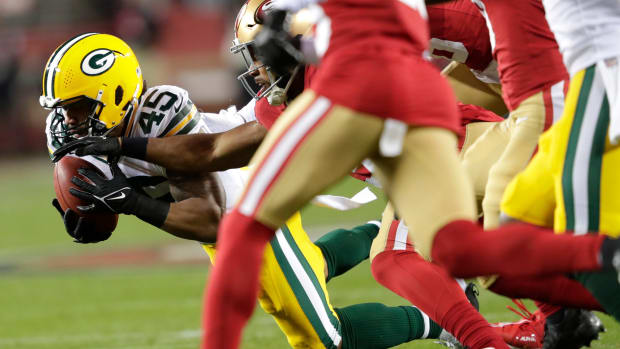
Packers 2024 Free Agent Tracker: Eric Wilson Re-Signs
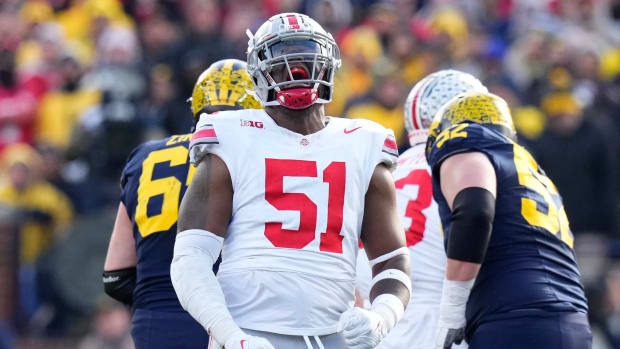
Packers Will Host Ohio State Defensive Lineman on Predraft Visit

Packers 2024 Draft Visits Tracker

NFL Free Agency Changes Packers’ Odds to Win NFC North

Top-Paid Players at Every Position After NFL Free Agency

Peace Through Strength? When Nixon Went to Moscow

- Video: Global Warming Lorem Ipsum Dolor Sit ...
- Article: Global Warming Lorem Ipsum Dolor Sit ...
- Entry: Global Warming Lorem Ipsum Dolor Sit ...
On May 22, 1972, Richard Nixon became the first American president to visit Moscow, the capital and largest city of what was then the Union of Soviet Socialist Republics. The nine-day summit came on the heels of Nixon’s more famous visit to China earlier in the year, when he and Chairman Mao reinitiated Chinese-American relations and began a long process of reintegrating the two societies’ political, cultural, and economic institutions. (Nixon, in 1959, visited Moscow as vice-president, something I’ll write about it July, so stay tuned!)
So why did Nixon, one of the most ardent anti-Communists in American politics during the late 1960s and early 1970s, go to Moscow at the height of the Cold War? How was he able to even pull it off? The counterintuitive answer is that it was because he was so hawkish. Only Nixon could go to the Soviet Union (and China earlier in 1972).
Nixon’s anti-Communist credentials were so sound that he could spend political capital making inroads with Communist enemies. His actions were viewed as safe by the American electorate because, for better or worse, the public saw Nixon as somebody who would not betray American values at the negotiating table with the Soviets. Nixon’s hawkishness provided moral cover for America’s withdrawal from Vietnam, and its peaceful overtures to the two most powerful and aggressively anti-capitalist regimes in the world (China and the USSR).
This dynamic plays out in a number of examples in the world today, too. Donald Trump comes to mind, of course, but so does Narendra Modi’s populist regime in India (relations between India and Pakistan have never been so peaceful). Xi Jinping’s China can also be viewed in this light. At home, Chairman Xi is a strident nationalist, but abroad, he and his policymakers have been vigorously building multilateral relationships with Asia, Africa, Latin America, Europe, and even the United States using that hawkishness at home as one of its diplomatic cards at the negotiating table. In the past, Otto von Bismarck’s German federation achieved peace on the European continent through strength.
Anecdotally, Republicans from California tend to be a bit more hawkish than their national counterparts. Nixon and Reagan come to mind, but so do many of California’s GOP members in the House of Representatives today. This is due, in part, to the fact that California is so far to the left that GOP operatives have to distinguish their differences with Democrats in a more pronounced manner. California’s Democrats are, for better or worse, viewed as the standard-bearers for all things left-wing today: big government, open immigration (whether legal or not), and world peace. This is a caricature, of course, since people like Nancy Pelosi and Babs Boxer have easily traceable hawkish records on policies like foreign affairs, but that’s just the nature of electoral politics in one-party states and of the narrative of our media establishment. California’s Republicans, outnumbered and always under attack, have no other option but to oppose instinctively their counterparts’ public aura. If the Democrats there are in favor of peace with communists (even if their voting record says otherwise), the Republicans have to go to their constituents and say they are against it.
Nixon was the first president to visit Moscow. FDR had visited the Soviet Union in 1945, but the conference he attended, along with Winston Churchill and Josef Stalin, was held at Yalta, a resort town in present-day Crimea. The Moscow Summit itself was rather interesting, too. Nixon signed numerous accords with the Soviet Union while there, but he did so with numerous heads of Soviet bureaucracies rather than solely with Brezhnev. What this can tell us is that the Soviet Union was far more decentralized in 1972 than many hawkish (and ideological) observers claimed.
After Stalin’s butcherous rein, Khrushchev came to power and tried to eliminate the brutal elements of Stalin’s regime while simultaneously wielding the power Stalin had held. But power thrives on fear and violence, and reformers took advantage of Khrushchev’s less brutal approach to institute a number of reforms in governance, including the dismantling of the General Secretary’s omnipotent position in the USSR’s political hierarchy. What emerged by the time Khrushchev’s successor, Brezhnev, came to govern was a much more decentralized political structure that sought to realize a true union of Soviet socialist republics. The fact that this realization still failed to replace capitalism as a superior producer of goods, services, and human freedom should not shroud the fact that reform was achieved in the Soviet Union. Indeed, the fact that hard-fought reform in Soviet civil and political life failed to achieve any of the USSR’s economic goals is a strength when pointing out socialism’s long list of failures.
Incidentally, one of the reasons I didn’t include Gorbachev in the l ist of dictators who “gave up” power is because he wasn’t a dictator. Gorbachev inherited a political system that was decentralized and dedicated to representativeness. If anything, the executive branch of the USSR was more decentralized than its American counterpart, a fact illustrated best by Nixon having to sign accords with a number of high-ranking Soviet officials.
So what can all this history teach us about today’s world? I look at hawks and doves. Hawks may make boorish claims, and they may say stupid things, but maybe, just maybe, we should give the hawks a chance.
Brandon Christensen is a weekly columnist at RealClearHistory and a contributor to the site's Historiat blog. He's also a member of the Notes On Liberty blogging consortium and currently writes from Texas.


IMAGES
VIDEO
COMMENTS
Babies tend to sprout their first tooth around 6 months old. And more are usually quick to follow. So, scheduling that first dentist visit right around their first birthday is a safe bet for most ...
The first dental visit is recommended by 12 months of age, or within 6 months of the first tooth coming in. The first visit often lasts 30 to 45 minutes. Depending on your child's age, the visit may include a full exam of the teeth, jaws, bite, gums, and oral tissues to check growth and development. If needed, your child may also have a gentle ...
When to schedule baby's first dental visit. It might sound early, but aim to schedule your baby's first dentist appointment at a pediatric dentist (or one who's good with children) within 6 months of the time he sprouts a tooth or turns a year old, whichever comes first, according to the latest guidelines from the American Academy of Pediatrics (AAP) and the American Academy of Pediatric ...
What to Expect. At the first visit, the dentist will examine your baby's mouth to make sure everything is growing and developing properly and will check for dental caries, tongue ties, and any signs of injuries. The dentist will typically tell you everything you need to know to keep your child's teeth healthy including:
During your child's first dental appointment, a dentist or hygienist will look at your child's teeth, gums and overall mouth to ensure that everything is developing on schedule. Specifically, they'll be on the lookout for cavities, gum problems and any signs of mouth injuries. Depending on your child's age and risk for tooth decay, the ...
At your child's first dental visit, you can expect to be there for no more than 45 minutes. Their dentist will conduct a regular exam which includes checking your baby's teeth for tooth decay, pacifier teeth, gum condition, and bite. If they think it necessary, they may do a gentle cleaning and polish too. Unless there's an issue, you ...
The dentist will examine your child to make sure their jaw and teeth are developing in the way they should. During the visit, you will be seated in the dental chair with your child on your lap if your child isn't able to — or doesn't want to — sit in the chair alone. The dentist will check for mouth injuries, cavities or other issues.
Start Early: Introduce your child to visiting the dentist as a positive and essential part of caring for his teeth and keeping a healthy smile. Use Positive Language: When discussing the dental visit, use positive and reassuring language. Avoid using words like "pain," "hurt," or "shot." Instead, focus on explaining that the dentist will check ...
The first dental visit is recommended by 12 months of age, or within 6 months of the first tooth coming in. The first visit often lasts 30 to 45 minutes. Depending on your child's age, the visit may include a full exam of the teeth, jaws, bite, gums, and oral tissues to check growth and development. If needed, your child may also have a gentle ...
The first dental visit is recommended by 12 months of age, or within 6 months of the first tooth coming in. The first visit often lasts 30 to 45 minutes. Depending on your child's age, the visit may include a full exam of the teeth, jaws, bite, gums, and oral tissues to check growth and development.
In advance of the visit, give them an idea of what to expect: Go over what will happen at the appointment (more on that below). And be sure not to pass on any personal fear you may have of dentists to your child. Give them every opportunity to enjoy their first visit. Explain why it's important to go to the dentist and how it keeps them healthy.
6 months to 18 months. Babies, she says, are the simplest of the age groups to prepare. For the youngest among them, all that's really needed is to come and sit in the chair. However, as kids approach the 1-year mark and head toward their toddler years, there are a few tricks parents may want to employ. "They're very inquisitive at this ...
The American Academy of Pediatric Dentistry and the American Academy of Pediatrics both recommend that children see a dentist by their first birthday, or within six months after their first tooth appears. This may seem early, but it's important to establish good dental habits from a young age. A pediatric dentist can also check for any ...
The recommendation for a child's first dental visit to occur at or before age 1 has been the standard since 2001. Yet, practically speaking, dentistry for patients under the age of 3 continues to be largely spoken of didactically, and not widely implemented clinically in general practice. This is not a criticism as much as an observation.
The first dental visit consisted of a visual examination of the oral cavity with the aid of a dental mirror and a dental probe to assess the oral health status of the child. A tell-show-do approach was utilized. No operative procedures (e.g., fillings or X-rays) were performed. At the end of the dental visit, the principal investigator ...
The first dental visit is recommended by 12 months of age, or within 6 months of the first tooth coming in. The first visit often lasts 30 to 45 minutes. Depending on your child's age, the visit may include a full exam of the teeth, jaws, bite, gums, and oral tissues to check growth and development. If needed, your child may also have a gentle ...
Development of a Personalized Dental Care Plan. The goal of your first visit to a new dentist's office is to give the dentist a window into your oral health so they can tailor-make a dental care plan just for you. When it comes to dentistry, dental care plans are not one size fits all. Communicating your concerns, habits, and what you hope to ...
You'll have fresher breath, too. When the dentist probes your teeth and checks the gums for pockets, it may hurt and bleed a bit. The pain shouldn't last long. Don't be overwhelmed if the dentist ...
In this article, we will guide you through the process of determining when to schedule that all-important first dental appointment. Recommended Age for the First Dental Visit. The American Dental Association (ADA) recommends that a child's first dental visit should ideally occur by their first birthday or within six months of the eruption of ...
There is ample parking and shopping after your visit! Conveniently located at the Palouse Mall. Address 2016 W. Pullman Rd. Moscow, ID 83843. Hours Monday—Thursday: 8:00AM-5:00PM Friday: 9:00AM-1:00PM (secretary only) Phone 208-882-0991 Email [email protected]. Our Office.
CONCORD, N.H. (AP) — Tucked away inside the teachers lounge at a New Hampshire elementary school, Amber Warner was having her teeth checked out for the first time. The 5-year-old sat back on ...
Meet Our Clear Aligner Specialists | Motto Clear Aligner Team. Trust 25+ years of straighter smiles. When you choose Motto® clear aligners, you get a care team supported, by Dr. Payam Ataii. His decades of attentive care, craftsmanship and compassion has created thousands of happier and straighter smiles. Schedule appointment.
History. Our Mission At Nature's Way Dentistry is to have the healthiest patient population on the Palouse. This does not just mean your oral health, but your whole-body, or holistic, health.
Georgia's mammoth Amarius Mims, who allowed just one pressure in 2023, is set for a predraft visit with the Green Bay Packers. With the free-agent departure of Yosh Njiman and the release of David ...
President Joe Biden spoke on the phone with Chinese President Xi Jinping on Tuesday, marking the first conversation between the leaders since their historic in-person summit in November and the ...
When Nixon Went to Moscow. On May 22, 1972, Richard Nixon became the first American president to visit Moscow, the capital and largest city of what was then the Union of Soviet Socialist Republics. The nine-day summit came on the heels of Nixon's more famous visit to China earlier in the year, when he and Chairman Mao reinitiated Chinese ...
Get reviews, hours, directions, coupons and more for Sept, Matthew J, DMD. Search for other Dentists on The Real Yellow Pages®.
Biden and first lady Dr. Jill Biden will welcome Kishida and his wife, Kishida Yuko, to Washington on April 8 for a meeting. The news conference will take place April 10, followed by the state dinner.